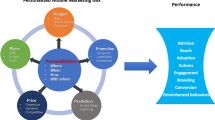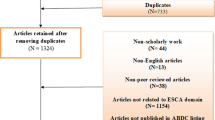Abstract
Most of existing e-commerce recommender systems have been designed to recommend the right products to users, based on the history of previous users’ individual transaction records. The real application scenarios of recommendation also have different requirements. From the customer point of view, many users visit the websites anonymously, so a practical way to provide anonymous recommendation is needed. From the marketing point of view, the recommendation list is not only a place to display the correlation of products, but also a place to display the variety of products as well as a tool to promote products. From the data point of view, concentration bias may be a serious problem. In this paper we propose trigger and triggered (TT) model to address all of these issues. First, the proposed model generates trigger and triggered pairs with significant correlations which can be used either to create a practical anonymous recommendation or as an input for products lifecycle modeling. The generated pairs not only reflect the relationships between products but also solve the problem of concentration bias very well. Besides, exposure of products required by marketing can be accomplished in the modeling. Second, by using the pairwise knowledge from the first step, the proposed model can recommend the right product at the right time to stimulate future consumptions and increase customers’ engagement for the off-site case. A real-life retail store data is used to evaluate the proposed model, and the experimental results show that the model can decrease the problem of concentration bias while improving the correlation between recommendation items. The TT model significantly improves the sequential purchases on triggered items.







Similar content being viewed by others
References
Pennock, D. M., Horvitz, E., Lawrence, S., Giles, C. L.: Collaborative filtering by personality diagnosis: a hybrid memory- and model-based approach. Sixteenth Conference on Uncertainty in Artificial Intelligence, 473–480, (2000)
Sarwar, B., Karypis, G., Konstan, J., Riedl, J.: Item-based collaborative filtering recommendation algorithms. International Conference on World Wide Web, 285–295 (2001)
Yang, X., Guo, Y., Liu, Y.: Bayesian-inference-based recommendation in online social networks. IEEE Trans. Parallel Distrib. Syst. 24(4), 642–651 (2013)
Hofmann, T.: Latent semantic models for collaborative filtering. ACM Trans. Inf. Syst. 22(1), 89–115 (2004)
Hu, Y., Koren, Y., Volinsky, C.: Collaborative filtering for implicit feedback datasets. Eighth IEEE International Conference on Data Mining, 263–272, (2009)
Koren, Y.: Factorization meets the neighborhood: a multifaceted collaborative filtering model. ACM SIGKDD International Conference on Knowledge Discovery and Data Mining: 426–434 (2008)
Nguyen, T. T., Hui, P. M., Harper, F. M., Terveen, L., Konstan, J. A.: Exploring the filter bubble: The effect of using recommender systems on content diversity. Proceedings of the 23rd international conference on World wide web (2014)
Adamopoulos, P., Alexander, T.: On over-specialization and concentration bias of recommendations: Probabilistic neighborhood selection in collaborative filtering systems. Proceedings of the 8th ACM Conference on Recommender systems (2014)
Iii, J.E.P., Wiener, J.G., Smith, M.H.: The Weibull distribution: a new method of summarizing survivorship data. Ecology. 59(1), 175–179 (1978)
Solow, D.: Linear and Nonlinear Programming. Wiley Encyclopedia of Computer Science and Engineering (2007)
Shanno, D.F.: On broyden-fletcher-goldfarb-shanno method. J. Optim. Theory Appl. 46(1), 87–94 (1985)
Bottou, L.: Large-scale machine learning with stochastic gradient descent: 177–186, (2010)
Hager, W.W., Zhang, and Hongchao: A new conjugate gradient method with guaranteed descent and an efficient line search. SIAM J. Optim. 16(1), 170–192 (2005)
Celma, Ò., Herrera, P.: A new approach to evaluating novel recommendations. 13(8), 179–186 (2008)
Herlocker, J.L., Konstan, J.A., Terveen, L.G., Riedl, J.T.: Evaluating collaborative filtering recommender systems. ACM Trans. Inform. Syst. 22(1), 5–53 (2004)
Fleder, D. M., Hosanagar, K.: Recommender systems and their impact on sales diversity. ACM Conference on Electronic Commerce: 192–199 (2007)
Zhang, L., Li, J., Li, A., Zhang, P., Nie, G., Shi, Y.: A new research field: intelligent knowledge management. International Conference on Business Intelligence and Financial Engineering, 450–454, (2009)
Nie, G., Zhang, L., Zhang, Y., Deng, W., Shi, Y.: Find intelligent knowledge by second-order mining: three cases from China. IEEE International Conference on Data Mining Workshops, 1189–1195 (2010)
Wang, J., Zhang, Y.: Opportunity model for e-commerce recommendation: right product; right time. International ACM SIGIR Conference on Research and Development in Information Retrieval, 303–312 (2013)
Nash, J. C., Varadhan, R., Grothendieck, G., Nash, M. J. C., Yes, L.: Package ‘optimr’, (2016)
Davenport, T. H.: What do we talk about when we talk about analytics. Enterprise analytics, optimize performance, process and decision through big data, 9–18, (2013)
Nassar, M.M., Eissa, F.H.: On the Exponentiated Weibull distribution. Commun. Stat. 32(7), 1317–1336 (2003)
Aurélien, A. G.: Hands-on machine learning with Scikit-Learn and TensorFlow: concepts, tools, and techniques to build intelligent systems. O'Reilly Media Inc (2017)
Funding
This work was partially supported by grants from National Natural Science Foundation of China (No. 91546201, No. 71331005, No. 7193000078).
Author information
Authors and Affiliations
Corresponding authors
Ethics declarations
Conflict of interest
The authors declare that they have no conflict of interest.
Ethical approval
This article does not contain any studies with human participants or animals performed by any of the authors.
Additional information
Publisher’s note
Springer Nature remains neutral with regard to jurisdictional claims in published maps and institutional affiliations.
Rights and permissions
About this article
Cite this article
Deng, W., Shi, Y., Chen, Z. et al. Recommender system for marketing optimization. World Wide Web 23, 1497–1517 (2020). https://doi.org/10.1007/s11280-019-00738-1
Received:
Revised:
Accepted:
Published:
Issue Date:
DOI: https://doi.org/10.1007/s11280-019-00738-1




